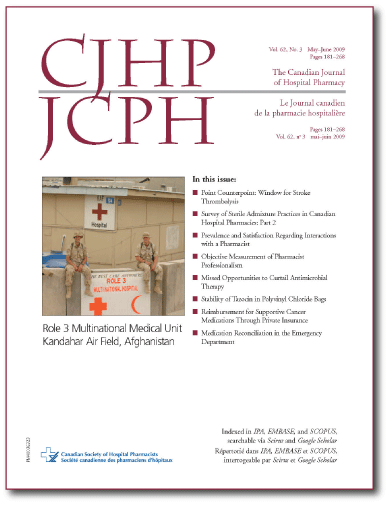Medication Reconciliation by a Pharmacist in the Emergency Department: A Pilot Project
DOI:
https://doi.org/10.4212/cjhp.v62i3.794Abstract
INTRODUCTION
The Institute for Healthcare Improvement has defined medication reconciliation as “a formal process of obtaining a complete and accurate list of each patient’s current home medications—including name, dosage, frequency and route— and comparing the physician’s admission, transfer, and/or discharge orders to that list. Discrepancies are brought to the attention of the prescriber and, if appropriate, changes are made to the orders.”1 The impetus behind this concept is to prevent adverse drug events. The Canadian Adverse Events Study reported an adverse event rate of 7.5% in Canadian hospitals, and 36% of the adverse events were deemed preventable.2 Drug- and fluidrelated events together constituted the second most common type of adverse event.2 Medication discrepancies can occur at any point in the medication use process, but the largest percentage of these discrepancies occur during the prescribing phase.3-7 The presence of a pharmacist during patient care rounds and when prescriptions are written has been associated with a reduction in medication discrepancies at the ordering stage.8-10 In a sample of 98 emergency department visits, the accuracy of medication lists completed by the triage nurse was 42.6%.11 Most physicians rely on patients’ drug lists when making a diagnosis and ordering tests and medications in the emergency department. However, without appropriate verification of the patient’s medication regimen, drug-related problems may not be detected, a diagnosis may be missed, or discrepancies in patient admission orders may occur.3,12-14 A few studies regarding medication reconciliation conducted in larger teaching centres have been published3,15; however, there are no similar published studies from small community hospitals. Colchester Regional Hospital is a 120-bed community hospital offering medical, surgical, psychiatric, pediatric, and obstetric services. The hospital has about 3000 admissions per year with a maximum capacity of 11 beds in the Emergency Department. Before the study, the hospital’s pharmacists were involved in direct patient care in the acute care units and provided seamless care at discharge to about 60% of patients treated in these units. Many of the interventions at discharge were performed to correct discrepancies in the admission orders prepared in the Emergency Department. Given that about 80% of the hospital’s admissions originate in the Emergency Department, the authors theorized that involving a pharmacist earlier in the process would lead to more timely interventions and would help to prevent medication discrepancies. The purposes of this study were to determine if involving a pharmacist in the documentation and reconciliation of medications in the Emergency Department would result in fewer medication discrepancies and to evaluate a multidisciplinary form for medication reconciliation in the Emergency Department.
Downloads
Downloads
Issue
Section
License
Copyright © Canadian Society of Healthcare-Systems Pharmacy.
After publication of a manuscript in the CJHP, the authors of the manuscript must obtain written permission from the CSHP (publications@cshp.ca) before reproducing any text, figures, tables, or illustrations from the work in future works of their own. If a submitted manuscript is declined for publication in the CJHP, all said rights shall revert to the authors. Please note that any forms (e.g., preprinted orders and patient intake forms) used by a specific hospital or other health care facility and included as illustrative material with a manuscript are exempt from this copyright transfer. The CJHP will require a letter from the hospital or health care facility granting permission to publish the document(s).










